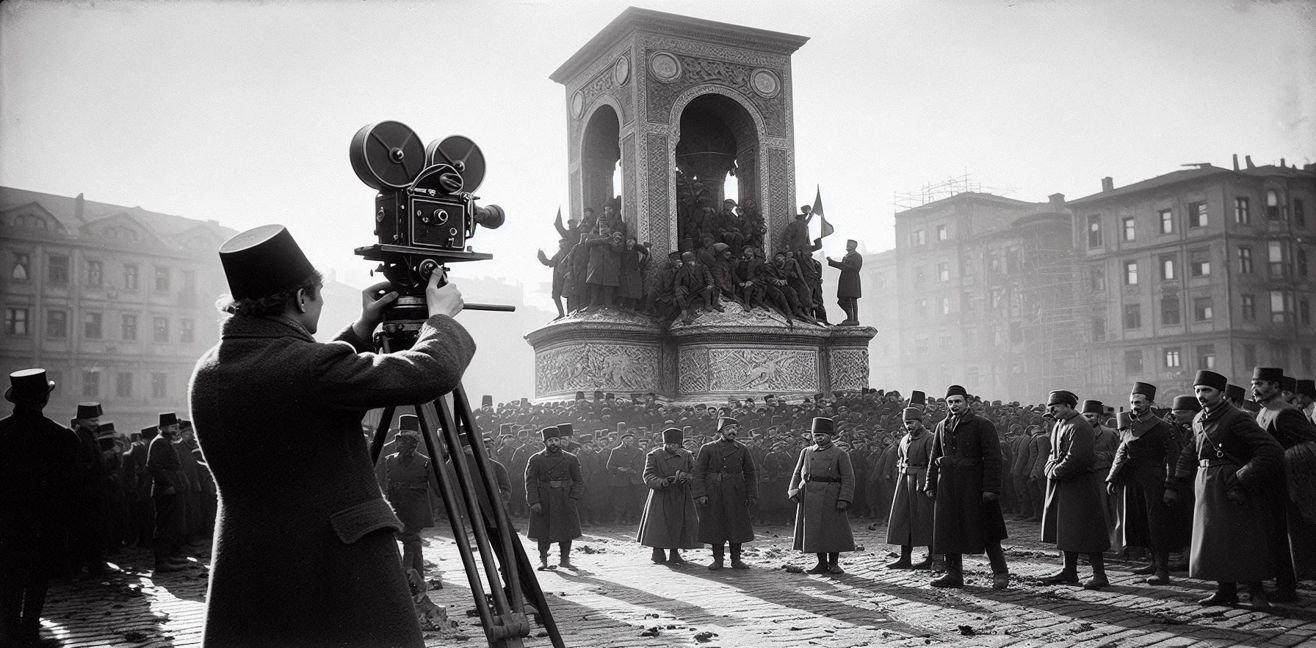1914… Trams are clattering through Istanbul, fez-wearing gentlemen and parasol-holding ladies stroll the streets. No one’s worried about “Oscar ceremonies” yet, but cinema is becoming a newly rising star in the world. And right at this moment, a man steps onto the stage who will have his name written in golden letters in the history of Turkish cinema: Fuat Uzkınay.
🏛️ A Monument, a Camera, and an Idea
In the Ayastefanos district (today’s Yeşilköy), there stood a massive Russian Monument, erected after the 1877-78 Ottoman–Russian War. For the Ottoman people, it wasn’t exactly a cherished symbol. After the Ottoman Empire entered World War I, a decision was made: “This monument can’t stay here any longer.”
And this is when one of the most important lines in our cinema history was spoken:
“Let’s film it.”
📽️ The Camera: Definitely Not a “Phone”
The camera Fuat Uzkınay used was nothing like today’s “flip your phone, hit REC” convenience. It was a heavy, hand-cranked device using 35 mm film. Tripods weren’t lightweight, and “run-and-gun” shooting was out of the question.
- Frame rate: About 16 frames per second – meaning the footage would look a bit “faster” than modern films.
- Sound? None! All films were silent. You could only imagine the rumble of the demolition.
- Editing? Done manually with scissors and tape – “Ctrl+C, Ctrl+V” didn’t even exist in dreams yet.
🎭 Acting?
The Demolition of the Russian Monument at Ayastefanos was more of a documentary, so there were no professional actors. Let’s just say: “Starring: real people.” But in the cinema culture of the time, acting meant exaggerated gestures and facial expressions – because in silent films, you had to show every emotion through your face and body.
- Most cinema actors came from theatre, so their performances were “overly theatrical” on camera.
- Eyes opened wide, hands gestured dramatically, and the look said it all.
In this film, the only “performance” belonged to the demolition crew. Imagine seeing a camera for the first time in your life, and someone telling you, “Whatever you do, don’t stare curiously into it.” 😄
🌆 The Atmosphere of the Day
The camera was set up, the crowd gathered, everyone curious. Given the technical limitations of the time, the camera position was most likely fixed. Panning (side-to-side movement) or tilting (up-and-down) was very limited. The demolition was probably filmed from a single angle, maybe with a small zoom-in.
🎞️ A 150-Meter Slice of History
A 150-meter film reel would only last a few minutes. These brief scenes might have been shown the following week in Istanbul’s Beyoğlu cinemas. At the time, short documentaries, war updates, and public announcements were often screened before feature films.
💔 Sadly Lost
Over the years, war, lack of proper archives, and neglect caused the film to be lost. Today, we have neither a single frame nor a copy. But historical records confirm that this film is considered the first Turkish-made production.
🎬 Fuat Uzkınay’s Contributions
- Introduced cinema equipment to the army.
- Filmed scenes from the front during the war.
- Laid the technical foundations of Turkish cinema.
- Helped spread cinema culture throughout the country.
✨ Final Words
On that day, Fuat Uzkınay’s camera didn’t just record the demolition of a monument; it pressed the “record” button on an entire nation’s cinematic history. Those heavy cameras, the silent film format, the theatre-rooted gestures, and the limited technical means became the ancestors of today’s massive sets and CGI effects.
We may not be able to watch that film, but the cinematic wave it created is still reflected on the silver screen.



